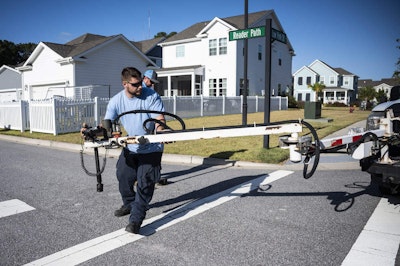
Carlos Smalls connects a vacuum tube extension while cleaning a wastewater wet well for Mount Pleasant Waterworks in South Carolina.
Interested in Infrastructure?
Get Infrastructure articles, news and videos right in your inbox! Sign up now.
Infrastructure + Get AlertsOne can’t look long at Mount Pleasant Waterworks without seeing a pattern of responsible management. The South Carolina utility has a penchant for positioning itself to function reliably.
General Manager Allan Clum doesn’t take the credit for the utility’s performance — in fact, he generally attributes it to his staff. After all, Clum has only been in charge since July 2021. However, he was a Waterworks staffer himself, beginning in 2006 when he was hired to manage the utility’s laboratory. The lab scientist eventually was promoted to manage wastewater, then operations, then the entire organization — another pattern worth noting.
Inside jobs
Much of Mount Pleasant’s underground infrastructure dates from the 1990s when the Charleston suburb doubled in size. Most of the town’s water and sewer pipe is PVC or ductile iron and generally in good shape, according to Clum.
Yet keeping a thousand miles of sewer and waterlines (the typical water main is 8-inch pipe), 164 wastewater pump stations and 4,100 hydrants performing at a high level is a challenge. The utility budgets between $20 million and $30 million year for maintenance and capital projects, most of which the Waterworks crew takes on itself.
“We sort of have a philosophy here,” says the 48-year-old general manager. “Any task related to sewer and water, we can do as well as anyone else. We take pride in really trying to do any needed work ourselves. That offers us the best control of a project and at a better price most of the time.”
To that end, crews have at their disposal a variety of Caterpillar equipment along with a Vacall AJV 1215 jet/vac truck with a 12-cubic-yard debris tank and 1,500-gallon water tank, and a US Jetting combo unit.
To check pipe conditions before and after cleaning, they have an inspection van outfitted with CUES camera equipment. If their inspection shows damaged-but-repairable pipe, they contract the lining work.
One such project was the connecting of the water systems of Mount Pleasant and Charleston via a pipe threaded under the Intracoastal Waterway to nearby Sullivan’s Island, which is part of Charleston’s water system. The project followed a South Carolina environmental agency’s ruling that Mount Pleasant reduce the amount of water it draws from the Charleston Aquifer.
The project gave Mount Pleasant its third point of delivery to an alternate source of water and each community a water backup in emergencies — again, redundancy and resiliency. The town and city split the $8.5 million cost of the project. It involved boring a tunnel some 90 feet beneath the Intracoastal Waterway using a horizontal directional drill and pulling back 5,000 feet of 18-inch-diameter steel pipe.
The project is evidence of the utility’s good relationship with area water systems, including Charleston, where Clum worked for a while. “I have personal relationships there and the two utilities are invested in each other,” he says. “We have a 30-year reciprocal agreement with the city for water purchases as needed. Both utilities have benefited from the relationship.”
Mount Pleasant Waterworks is a separate entity from the town, so maintaining a working relationship with the town government also is essential. The utility’s governing board includes the mayor, a councilman who heads the water supply committee, and five publicly elected board members. “We have very good relations with the town,” Clum says, including cooperation on capital projects. “Our engineers meet frequently with the town engineering team.”
Well equipped
The Lowcountry is vulnerable when ocean storms come ashore. Hurricane Ian struck Mount Pleasant Sept. 30 as a Category 1 storm, having expended much of its energy across Florida the previous two days. Despite 85 mph winds that created 3- to 6-foot surges of seawater, the community was not severely damaged.
Clum says the utility took the storm in stride. “We did close the office for three days, but we’re pretty accustomed to hurricanes and emergency operations.” Though half of the sewer system pump stations lost power, backup generators kicked in as programmed and kept sewage moving. “We are well-equipped and experienced with storms. We really didn’t have any major issues. I think we managed the storm very well.”
The surge of ocean water had no impact on the town’s water supply. While the utility does purchase treated surface water from Charleston Water System, most of its water is still pulled from the Charleston Aquifer some 2,000 feet underground, far away from disruptive storms. Clum is a South Carolina native and recalls when Hurricane Hugo — a Category 5 storm — battered the Charleston area in 1989 and pine trees were blown into reservoirs and tainted the water. That wasn’t a factor in 2022.
Mount Pleasant Waterworks does serve a couple of hospitals — critical-need customers. The utility makes sure that such customers have uninterrupted water and sewer service during and after storms. Because the town is a residential suburb, with no industries aside from a craft brewery, the utility generally isn’t pressured to meet industrial water demands.
“The revenue side of the house might enjoy some industrial base load, though,” Clum quips, acknowledging the upside of having industrial customers to worry about. The town’s residential customers are not taxing the system — half of them using less than 3,000 gallons a month. Mount Pleasant Waterworks’ average residential bill is $74.
Ice storms visit the region periodically, with one of the worst striking a half dozen years ago. That storm uncovered an ironic weakness in the town’s water system. Waterworks built its reverse osmosis water treatment plants in four areas of the town and interconnected them for resiliency and to better serve the system. The conscientious spacing of plants became problematic when roads got icy.
“In the ice storm, our biggest concern became moving equipment along the streets to reach the treatment plants,” Clum recalls. “A geographically dispersed treatment system became a problem for us because we couldn’t drive to them.” While operating the plants remotely proved to work, the inability to have eyes on the process caused consternation.
In any event, with monster hurricanes not the rule and freeze-thaw damage to waterlines not an issue, focus is on two long-term concerns.
One is the future need to increase the quantity of water available to the system. A partial remedy is to grow the water reuse program. Nonpotable treated water currently is used to irrigate ballfields in the town’s sports complex. Reusing treated water in potable situations — for cooking and drinking — is the focus of pilot studies, but there is no timetable for it being a significant factor in the system’s potable water supply. More urgently, the town is looking at tapping a second aquifer.
The second issue is closer to finding resolution: a long-term plan to accommodate biosolids. In Mount Pleasant, the nutrient-rich organic material is generated by two wastewater treatment plants with the combined capacity to process nearly 13 mgd of sewage.
“We have to do better with our biosolids,” Clum says. “We are landfilling it now, but that’s not sustainable and not the right answer. Land application has its own concerns. We’re partnering with others to come up with a regional solution.”
A regional authority has been formed to locate a site for a solids-handling center. What is envisioned is the waste material eventually feeding several processes, including a compost operation, anaerobic digestion, natural gas production and even a pelletized product.
Building culture
The most important relationships are within an organization and Mount Pleasant Waterworks has “a very long history of longevity of employees,” Clum says. He attributes it to the utility’s family culture. When he became general manager, he built on that culture.
“Coming in, the most important thing to me was the workforce,” he says. “It was my first initiative. Putting people in the right places. Cross-training. Getting our bench strength as robust as it could be. People understood that we were investing in and taking care of them.”
Having worked his way up through the ranks, Clum wanted to facilitate similar movement in team members. In his first year as general manager, the utility had 35 internal promotions out of 161 total employees. “What was really cool about that was, overall, we saved $200,000 by consolidating and realigning staff,” he says.
“The women and men on the staff are solving problems every day. We need to give them tools and encouragement. My general philosophy is, if we take care of staff, the staff will take care of our customers.”
The general manager says the investment in utility staff, including cross-training, has resulted in a culture in which people have a desire to learn. The message the environmental scientist-turned-manager routinely sends to his team members is simple: Show up and work hard.
“I often say the key is, if you show up mentally and physically, there will be opportunities for you here.”







